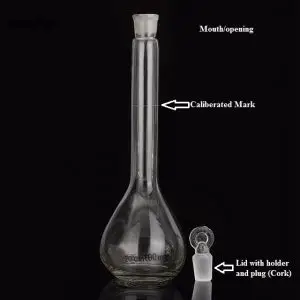A volumetric flask is a scientific instrument that is transparent and conical-shaped.
In most cases, it is glass labware used specifically to hold liquid materials.
Though one can find flasks made of plastic, the ones made of glass are preferred as they can hold harsh chemicals.
It is a graduated flask with calibration to hold a fixed volume at the mark provided near the neck.
It finds its use mainly in chemical, biochemical, clinical, and research labs.
Volumetric flask parts
The flask has two pieces, as seen in the picture below.
- The flask
- A small Cap or Lid (to close the flask mouth).
The flask is designed to accommodate the desired volume of the liquid up to the mark.
Also, there is a small amount of space above the mark to provide for mixing the liquid.
The cap is a small solid piece of glass with a plug or cork-like shape to fit into the flask’s mouth and also acts as a holder to hold it.
The lid fits precisely into the flask’s mouth without any chance of a leak in case the filled flask is vigorously shaken.
Procedure for the operation of the flask
Due to the possibility of shaking the liquids, it is widely used to make a mixture of liquids.
How to use a volumetric flask
When a small solution of solid or liquid has to be made,
a) A weighed quantity of solid or measured volume of liquid is first taken into the flask by pipette.
b) The solvent liquid is added to the flask to a level well below the mark.
c) The lid is closed, and the flask is tilted and shaken vigorously. This tilting creates space in the round portion of the flask and helps in effective mixing. Care should be taken to see that no liquid leads out of the lid.
d) Once the solute is thoroughly mixed, the lid is opened, and the flask is placed over a flat table. The solvent liquid is then carefully added to reach the mark.
e) The mark is considered reached when the liquid meniscus touches exactly the mark. The meniscus would be a concave one for aqueous solutions.
Thus fixed volumes of acids, bases, and buffers are made using the round bottom flask.
Available flask sizes

- The flasks are available in various sizes like 1 liter, 500ml, 250ml, 100ml, 50ml, 25ml, and 10ml.
- Even more, sizes could be available with vendors. Check with them if you need them in your labs.
Applications of the round bottom flask
- To make up for the desired volume of mixtures for analytical chemistry.
- As a measuring flask, it can be used to prepare the exact quantity of acids, bases, or buffers at the desired pH. For example, phosphate buffers of different pH are made using volumetric flasks and then stored till completion.
- For storage of prepared chemicals for future use. However, for light-sensitive chemicals, colored flasks are preferred.
When should a plastic volumetric flask be used instead of a more accurate glass flask?
Plastic volumetric flasks can be used when the solution to be made is dark or deep-colored.
Unless there is a risk of breakage due to accidental drop, one can use glass flasks instead.
Is a volumetric flask more accurate than a graduated cylinder
I believe so, but in practice, when both are graduated and supplied by a reputed company, the accuracy could be the same.
However, the chances of human errors are more with a graduated cylinder than a volumetric flask.
